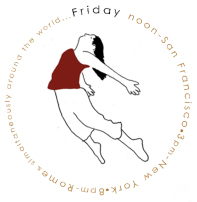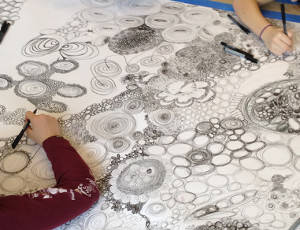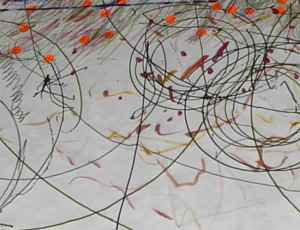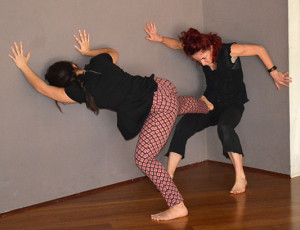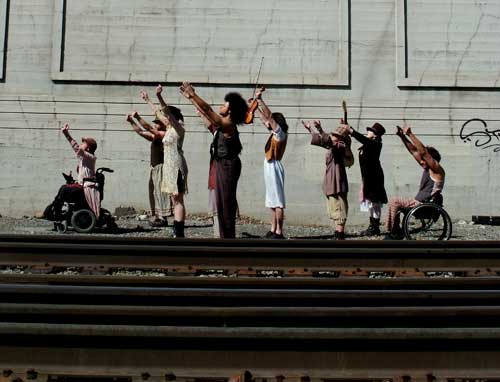
AXIS Dance Co. & Dandelion Dancetheater / photo: Luiza Silva
The Dislocation Express is a group of traveling performance artists who are truly taking the term “traveling” and running with it–literally. The brainchild of Eric Kupers, the artistic director of Dandelion Dancetheater, is teaming up with Axis Dance Company and celebrating the art of movement in a completely new way.
The Dislocation Express is founded on the notions of space and placement and our familiarity within these said arenas. What happens when we take the conventional comforts out of areas we occupy by constantly relocating? The Dislocation Express relies on the serendipitous feel of constant travel to liven each performance. They will start at one location and move to various others throughout each performance, narrated by dance and accompanied by music performed largely with ‘found objects’ such as wheelchairs, scrap metal, whistles, and more.
Taken in parts from “Hobo Culture”, the Dislocation Express and Axis Dance Company (recent guests on Fox’s “So You Think You Can Dance?”) celebrates the way our technologically obsessed culture looks at art, by constantly evolving and renewing. One minute you are comfortable within one given environment, the next you are uprooted into a completely different locale? How do we reconcile our desires to constantly advance with our impulse to nest? That is the question that can only be answered by the performers of The Dislocation Express and the audience members who become interactive voyeurs in the experience.
You can see a live performance of The Dislocation Express on Wednesday July 27th, Friday, July 29th, and Sat July 30th all at 6pm at the Ed Roberts Campus located at 3075 Adeline St., Berkley, CA 94703. The performances are free and open to the public and require no tickets or reservations. For more information, visit http://axisdance.org/TDE.php
Read on for a Q&A with Eric Kupers, the creative visioneer of Dislocation Express.
What was your inspiration that led you towards this venture? How do you think it has impacted you as a performer, choreographer?
This project has come out of nearly a decade of connection with AXIS Dance Company. I went to the company for guidance in making my work more inclusive, and one thing has led to another and now we’ve done many workshops, performances and other events together. This was a natural next step for us–to create an evening length work.
It’s taught me a lot. I was nervous about bringing our two companies together because of how these things can sometimes be disastrous in terms of conflicting styles and approaches. I think both companies came in with a great leaning towards openness and wanting to learn, and we have. It’s been an inspiring project. I’ve felt pushed to be do my best at all times, as it’s such a high caliber of artist in the room at each rehearsal, and it’s not just my own “family” I’m working with, but a whole other family too.
What has been the main difficulty in having a “traveling” performance?
Logistics, logistics, logistics. We have to basically build a makeshift theater from scratch at every site, on every day. Dealing with where the audience will be and how they will know what to do has taken the most effort. It has made me appreciate the simplicity of performing in theaters…yet I’m still committed to site specific work because of it’s ability to evoke wonder in anyone passing by.
How do you think the Dislocation Express will evolve in the future?
My guess is that after this performance run the Dislocation Express won’t be performed again. It’s very much about this particular group of artists coming together at this particular time around these particular themes. Both companies might take pieces of it into our repertory, but I think the full work is very fleeting.
What is the main component of the relationship to space and comfort within this project?
Both performers and audience members have to be willing to travel, to sit or stand outside on concrete, to be at the whim of the weather and any sound or visual distractions that arise and to not know what’s going to happen. That’s uncomfortable. It’s also exhilarating. It will be interesting to see what kind of person comes to this show and what their responses are.
How much of each performance is improvised, how much is choreography based?
A lot of both. We sustain the performance as we leave our first location and travel to our second, so in between each act is an hour long traveling improvisation. There’s a sound file for the audience to download and listen to on the way, with instructions that the performers will also be following for various movement activities on the train. We are going to have to improvise with the whatever conditions we find at each site, and with however the public responds.
And then in the actual structure of each act is a great deal of improvisation. We spent a long time improvising as an ensemble, and so have developed a common language that I trust.
People can download the soundfile here:
http://soundcloud.com/the-dislocation-express/the-dislocation-express

 Sign In
Sign In